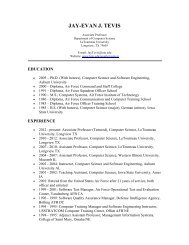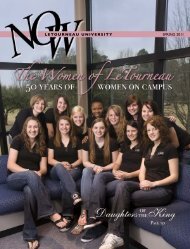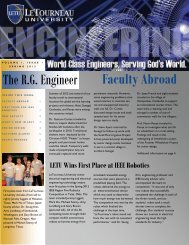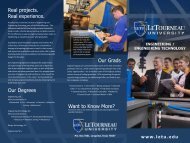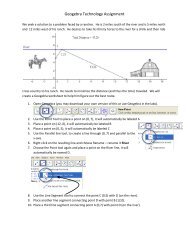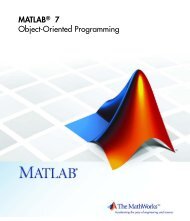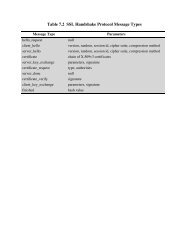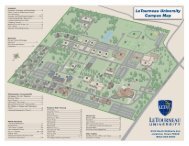Transient High-Frequency Welding Simulations of Dual-Phase Steels
Transient High-Frequency Welding Simulations of Dual-Phase Steels
Transient High-Frequency Welding Simulations of Dual-Phase Steels
You also want an ePaper? Increase the reach of your titles
YUMPU automatically turns print PDFs into web optimized ePapers that Google loves.
SUPPLEMENT TO THE WELDING JOURNAL, OCTOBER 2009Sponsored by the American <strong>Welding</strong> Society and the <strong>Welding</strong> Research Council<strong>Transient</strong> <strong>High</strong>-<strong>Frequency</strong> <strong>Welding</strong><strong>Simulations</strong> <strong>of</strong> <strong>Dual</strong>-<strong>Phase</strong> <strong>Steels</strong>Numerical and experimental simulations were used to investigate high-frequencywelding <strong>of</strong> advanced high-strength steelsBY R. BAUMER AND Y. ADONYIABSTRACTContinued development <strong>of</strong> advancedhigh-strength steel (AHSS) requiresa corresponding improvementin joining technology. One promisingjoining method is high-frequency buttjoint welding. Seeking to validate theutility <strong>of</strong> this process for joining AHSSflat sheet specimens for steel mill processinglines, high-frequency butt jointwelding <strong>of</strong> flat sheet steel was investigatedthrough a combined numericaland experimental simulation methodology.Simulated welds were producedand pre-Curie and post-Curie temperatureheating rate differences were observedwith infrared radiation (IR)imaging. Good correlations werefound between numerical predictionsand actual heating rates. Final metallographicanalysis revealed completecoalescence <strong>of</strong> faying surface, withonly minor hardening at the weld interface.It was concluded that high-frequencywelding shows good potentialfor coil joining in steel processinglines.IntroductionModern steel coil processing lines(such as pickling and galvanizing) benefitgreatly from a continuous feed <strong>of</strong> steelstrip, a process that requires coil end joining(Ref. 1). As is shown in Fig. 1, continuousprocessing is achieved through thecombined use <strong>of</strong> an accumulator (Fig. 1B)(Ref. 2) and a coil end welding machineR. BAUMER is a Graduate Student at MassachusettsInstitute <strong>of</strong> Technology, Cambridge,Mass. Y. ADONYI is the Omer Blodgett Pr<strong>of</strong>essor<strong>of</strong> <strong>Welding</strong> and Materials Joining Engineering atLeTourneau University, Longview, Tex.(Fig. 1C). Due to the finite capacity <strong>of</strong> theaccumulator, one main constraint on weldingprocess selection is welding speed. Additionalconstraints, such as materialthickness, result in a variety <strong>of</strong> weldingprocesses being used for coil end joining,including gas tungsten arc welding(GTAW), gas metal arc welding (GMAW),flash welding (FW), resistance (mash)seam welding (RSEW-MS), and laserbeam welding (LBW) (Ref. 3). Note thatthe last two are mostly used on tin coatingand recoiling lines, where the sheet thicknessis less than 1 mm.Joining <strong>of</strong> advanced high-strength steel(AHSS) coil ends brings additional challengesto coil end joining due to inherenthigh strength, prompting difficulties in endshearing, and faying surface alignment,and a propensity for localized hardeningin welding microstructures. Indeed, excessivehardness in the fusion and heataffectedzones has been reported in thecase <strong>of</strong> laser beam welding <strong>of</strong> dual-phase(DP) and transformation-induced plasticity(TRIP) steels (Ref. 4). The presence <strong>of</strong>such excessive hardness can provide a metallurgicalnotch, precipitating joint failureduring subsequent mill operations. Toeliminate potential problems stemmingfrom the as-cast microstructures found infusion welding, a solid-state weldingprocess is desired for joining AHSS coilends. While resistance welding (RW) andflash welding (both solid-state processes)are currently widely employed in coil joining,RW is slow and is limited to smallthicknesses (Ref. 1) while FW can be difficultto control because it is susceptible toKEYWORDS<strong>High</strong>-<strong>Frequency</strong> <strong>Welding</strong><strong>Dual</strong>-<strong>Phase</strong> <strong>Steels</strong>FEA ModelingHeating Ratesirregular arcing and incomplete fusion onthe strip edges. Even resultant strip breaks<strong>of</strong> 0.2% are not acceptable, as equipmentis damaged and production lost. Therefore,an improved solid-state joiningprocess is desired for joining AHSS coilends.Previous work has demonstrated that acoupled high-frequency induction heating/pressurewelding (termed hyper-interfacialbonding) operation can producefaying surface coalescence in butt joint configurationsand minimize thermally inducedchanges in grain size <strong>of</strong> ultrafine-grainedsteel (Ref. 5). Heating times for 5 × 5 × 30-mm specimens were shown to be very rapid(0.2 s to 1600°C at 1 MHz and 50–59 kW)(Ref. 5), indicating that high-frequencywelding can satisfy the time constraints associatedwith coil end joining.Additionally, previous research demonstratedthat high-frequency welding couldproduce good welds in AHSS specimens(Fig. 2), as evidenced by successful limiteddome height formability testing (Ref. 6).The long history <strong>of</strong> successful highfrequencyinduction welding (HFIW) <strong>of</strong>joints in tubular products and structuralshapes (Ref. 7) also suggests the usefulness<strong>of</strong> high-frequency welding for coil end joining.This present work builds on this foundationby developing numerical and experimentaltechniques for simulatinghigh-frequency welding <strong>of</strong> dual-phasesteel coil ends, thereby 1) providing insightinto fundamental high-frequency heating/materialinteractions, 2) establishingoperating parameters, and 3) demonstratingthe feasibility <strong>of</strong> joining DP steel coilends with high-frequency welding.Physical Simulation Overview<strong>High</strong>-frequency induction heating/pressure welding <strong>of</strong> dual-phase steels wasperformed at small scale through inductionheating using a solid-state-controlled, state<strong>of</strong>-the-art100-kW variable-frequencyWELDING RESEARCHWELDING JOURNAL 193-s
BACFig. 1 — Schematic representation <strong>of</strong> accumulator and coil end welding machineutilized in continuous steel strip processing mills. A — Strip to mill; B— accumulator — moving vertical rollers allow for a varying amount <strong>of</strong> stripto be stored, enabling the stored strip to be fed to the mill line while keepingthe coil end stationary; C — welding machine utilized to join the end <strong>of</strong> thecoil in the mill and the lead end <strong>of</strong> the next coil. (Fig. 1B reproduced afterRef. 2 with permission from MetalForming/PMA Services, Inc.)AAWELDING RESEARCHBFig. 2 — <strong>High</strong>-frequency welds made in advanced high-strength steels (differentcomposition than the DP600 but still possessing near 600 MPa ultimatetensile strength). A — As-welded specimens; B — transverse micrograph.Previously published in Ref. 6. Used with permission from US SteelResearch Europe, Kosice, Slovak Republic.Fig. 3 — A — Physical simulation setup. Note results reported in this presentinvestigation utilized a single-turn induction coil and did not use the two-turncoil shown above; B — electromagnetic model simulation geometry with representativemesh density; C — thermal model simulation geometry with representativemesh density.BC(250–400 kHz) induction welding powersupply. After heating specimens to forgingtemperatures and turning <strong>of</strong>f the inductioncoil power supply, controlled deformationwas delivered by the hydraulic ram system<strong>of</strong> a connected Gleeble 1500® thermomechanicalsimulator. All heating and deformationtiming was precisely controlled via aLabVIEW control program connecting thetwo systems. Small-scale welding specimens(1.5 × 44 × 89 mm) were rigidly constrainedin aluminum jaws and heated by a watercooled,copper induction coil — Fig. 3A. Atmosphericshielding was accomplished byflooding the welding chamber with argon.As compared to the industry standardhigh-frequency resistance welding (HFRW)<strong>of</strong>ten employed in tube welding (Ref. 7),the experimental simulation technique reportedhere is distinguished by 1) a transientprocess unable to reach thesteady-state operating condition characteristic<strong>of</strong> HFRW, 2) controlled relative motionbetween faying surfaces (i.e., notdependent upon the speed or V angle <strong>of</strong>the advancing pipe), and 3) variable frequencybetween 250 and 400 kHz using thelatest solid-state power control technology.Fundamentals <strong>of</strong> the Heating MechanismsHeating <strong>of</strong> welding specimen edgesprior to forging is the consequence <strong>of</strong> botheddy current heating, accentuated by theskin effect, and hysteresis heating (ferromagneticmaterials only). Eddy currentheating occurs due to resistive heatinglosses accompanying induced current flowin a material. By consequence <strong>of</strong> the skin194-s OCTOBER 2009, VOL. 88
ABFig. 4 — A — Comparison <strong>of</strong> numerical and experiment temperatures; B — heating rates vs. time at the faying surface (weld interface center). Numerical simulationresults for DP600 heated with a 1750-A induction coil current input (315 kHz). Physical experimental results shown for DP600 welded at 315 kHz and40 kW.effect, current distributions are restrictedto shallow penetration depths on fayingsurfaces, leading to rapid heating and highefficiencies (Ref. 8). For ferromagneticmaterials, hysteresis heating also occurs, adirect consequence <strong>of</strong> inelastic magnetization/demagnetization(represented bythe area enclosed by the BH curve <strong>of</strong> amaterial) (Ref. 9). Naturally, hysteresisheating ceases when the Curie temperature(approximately 1033 K for ferromagneticmaterials) (Ref. 10) is reached andmaterials become paramagnetic.Fundamentals <strong>of</strong> the DeformationMechanismsWeld quality in high-frequency weldingis strongly dependent upon the nature <strong>of</strong>deformation at the faying surface. Previousresearch indicates that control <strong>of</strong> deformationinput parameters <strong>of</strong> total faying surfaceupset, deformation strain rate, andforging operation temperatures canimprove coalescence <strong>of</strong> faying surfacesduring high-frequency welding <strong>of</strong> high-performancesteels (HPS) (Ref. 11). While thesignificance <strong>of</strong> thesemechanisms is certainlyrecognized inthis present research,neither total upsetnor deformation rateswere considered asprimary variables inthis initial processdevelopment, as fundamentalheating parameterswere <strong>of</strong>primary concern.ObjectivesThe purpose <strong>of</strong> Fig. 5 — Comparison <strong>of</strong> numerical and experiment temperature distributions.Experimental data obtained through static heating trials <strong>of</strong> DP600.this numerical andphysical simulationstudy was to understandand characterize the thermal phenomenagoverning the bond quality into future full-scale implementation.transient high-frequency joining <strong>of</strong> DP Methodologysteels. The study was also intended to validatethe concept <strong>of</strong> designing a steel coil Induction Heating Simulation Overviewjoining prototype and provide means tolink parametric effects found at small scale Induction heating is modeled by solv-WELDING RESEARCHTable 1 — Material Input Parameters for Numerical <strong>Simulations</strong> <strong>of</strong> <strong>High</strong>-<strong>Frequency</strong> Induction Heating <strong>of</strong> DP600 Sheet SteelTemp. Thermal Temp. Specific Temp. Resistivity Magnetic B H 293 K 523 K 773 K 1023 KK Conductivity Κ Heat K μΩ⋅m Loss Field Amp⋅m -1 μ r μ r μ r μ rW⋅m –1 ⋅Κ −1 J⋅kg –1 ⋅Κ −1 W⋅kg –1 T273 59.5 323 450 273 0.3 0.00 0 0 0.0 0.0 0.0 0.0373 57.8 473 520 373 0.38 5512 0.015 100 11.0 9.2 6.7 1.9473 53.2 573 565 473 0.44 22050 0.03 200 16.6 13.8 10.0 2.9573 49.4 623 590 573 0.42 49612 0.045 300 20.3 17.0 12.3 3.6673 45.6 723 650 673 0.65 88200 0.06 400 23.2 19.4 14.1 4.2773 41 823 730 773 0.78 137812 0.075 500 25.5 21.3 15.5 4.7873 36.8 973 825 873 0.92 198450 0.09 1000 35.2 29.5 21.6 6.8973 33.1 1023 1100 973 1.11 270112 0.105 2000 44.8 37.7 27.9 9.41073 28.5 1073 875 1073 1.34 352800 0.12 3000 50.7 42.9 31.9 11.41273 27.6 1123 846 1173 1.55 446512 0.135 4000 55.2 46.8 35.2 13.2Note: Thermal conductivity values were taken from SAE 1008 carbon steel (Ref. 18); specific heat capacity values were taken from SAE 1010 (323–1023 K) and SAE 1008 (1073–1123 K) (Ref. 16). Resistivity values were determined using DP980 (Ref. 17). Magnetic loss was determined at 280 kHz using Equation 9. Relative magnetic permeability wasdetermined using Equation 10.WELDING JOURNAL 195-s
ABWELDING RESEARCHing both the electromagnetic response to current flow through the heating coil and∇× =− ∂ BEthe thermal response <strong>of</strong> the specimen to∂teddy current and hysteresis heating. The electromagnetic regime is described by∇× = + ∂ DH JMaxwell’s equations and associated constitutiverelations (as given by Ref. 15) ∂t D = εE∇⋅ B = 0 (1) B = μH∇⋅ D = 0 (2) J = σECFig. 6 — Sample 18: DP 600, 42 kW, 315 kHz, 4 s heating. A — Welded sample; B — base metal; C — grain-refined zone; D — weld interface.(3)(4)(5)(6)(7)Dwhere B is magnetic induction, D is electricflux density, E is electric field strength,H is magnetic field strength, µ is magneticpermeability, ε is dielectric constant, andσ is conductivity.Solutions in the electromagneticregime yield eddy current and hysteresispower losses, which comprise the thermalgeneration term in the generalized heatequation (Refs. 12, 15)Table 2 — Representative Physical Simulation Input Parameters for DP600 and SAE 1018Material <strong>Frequency</strong> Power Gap Lift<strong>of</strong>f Upset Disp. Trial TimekHz kW mm mm mm Rate smm s –1SAE 1018 316 42 1 4 –1 10 4DP 600 315 42 1 4 –2 100 4SAE 1018 403 42 1 4 –2 20 4DP 600 398 42 1 4 –2 20 4Note: See Appendix 1 for all data.196-sOCTOBER 2009, VOL. 88
ABCFig. 7 — A — Temperature evolution at the weld interface for DP600; B — temperature evolution at the weld interface for SAE 1018; C — temperature distributionat time <strong>of</strong> maximum temperature (immediately prior to upset) <strong>of</strong> DP600; D — temperature distribution at time <strong>of</strong> maximum temperature (immediatelyprior to upset) <strong>of</strong> SAE 1018.Ḋ ∂∇⋅( k∇T)+ Q = ρC T ∂t(8)where Q is internal heat generation (in thisproblem, coming from hysteresis and eddycurrent power losses), k is thermal conductivity,ρ is density, and C is specificheat.Solving the heat equation yields the resultingtemperature distribution in the specimen.Due to the temperature dependence<strong>of</strong> all material properties, coupling betweenthe governing equations is highly nonlinear,requiring a numerical solution method.(Refer to Refs. 9 and 12–15 for detailed explanations<strong>of</strong> the governing equations andassociated numerical solutions.)In this present work, a systematic numericalsimulation <strong>of</strong> induction heating <strong>of</strong>flat sheet DP steels was conducted usingthe commercial finite element analysis(FEA) s<strong>of</strong>tware MagNet and ThermNetfrom Infolytica Corp. MagNet enables auser to model components and currentcarryingconductors (using a CAD-type interface)and solve for the resulting electromagneticfield interaction between thetwo via an FEA-based solution method.Solutions include static, time-harmonic,and transient responses in two or three dimensions.Similarly, ThermNet providesan FEA-based solution to the transientthermal response <strong>of</strong> a component subjectto heating or cooling phenomenon. Solutionsinclude static and transient responsesin two or three dimensions. Inductionheating is modeled by solving electromagneticand thermal systems together.Numerical Simulation: SpecimenGeometry, Mesh, and Boundary ConditionsModel geometry was defined in two dimensionsonly, operating under the assumptionthat edge heating effects werenegligible. <strong>Dual</strong>-phase steel welding specimenswere each said to be 1.6 mm thickand 43.5 mm in length, with a 1-mm rootopening between faying surfaces. The inductioncoil was modeled as a solid copperconductor <strong>of</strong> 6.35 mm diameter with alift<strong>of</strong>f <strong>of</strong> 4 mm. Aluminum jaws utilized tocontain specimens during physical trialswere also included in the model — Fig.3B. <strong>Simulations</strong> were conducted in a simulationcell (referred to as the AirBox) <strong>of</strong>dimensions 176 × 176 mm.Following the definition <strong>of</strong> specimengeometry, the second step in FEA implementationwas spatial discretization. In theelectromagnetic model, due to the rapidlychanging electromagnetic fields, the maximumelement size (MES) in the sample wasto be no larger than 0.25 mm. No MES wasspecified for the AirBox or the coil, and thecomputer generated one appropriate to thegeometry — Fig. 3C. For the thermalmodel, no maximum element size was setfor any part <strong>of</strong> the model, and an appropriatemesh was automatically generated —Fig. 3C. A polynomial order <strong>of</strong> two was setfor all element equations.The electromagnetic boundary conditionswere set to have flux lines tangentialto the AirBox perimeter and at the intersection<strong>of</strong> the AirBox with the sheet specimen.This facilitated the approximationWELDING RESEARCHWELDING JOURNAL 197-s
Fig. 8 — Resistivity vs. temperature pr<strong>of</strong>iles for DP600, DP980, and SAE1025. Resistivity data for SAE 1025 taken from Ref. 16. Resistivity <strong>of</strong> DPsteels determined through a modified form <strong>of</strong> ASTM B193-02 (Ref. 17).Fig. 9 — Hardness data on DP600 high-frequency welding simulationspecimens.WELDING RESEARCHthat the sheet specimen was being inductivelyheated in an infinitely large volume.In the thermal regime, the adiabaticboundary condition was applied to all surfaces,assuming that radiative and convectiveheat losses were small compared toconduction <strong>of</strong> heat within the specimen.Numerical Simulation: Material PropertiesMaterial properties requiring definitionfor successful FEA simulation <strong>of</strong> inductionheating are mass density, thermalconductivity, specific heat, electrical resistivity(or conductivity), magnetic loss (hysteresisloss), magnetic permeability, andelectric permittivity. Mass density wastaken to be 7600 kg . m 3 . Thermal conductivityand specific heat were determinedthrough handbook data for low-carbonsteel (Ref. 16), with the values defined asshown in Table 1. Electrical resistivity as afunction <strong>of</strong> temperature was measuredthrough a modified form <strong>of</strong> ASTM B-193(Ref. 17) (Table 1). While simulationswere based on resistivity data collected onDP980, additional resistivity testing <strong>of</strong>DP600 demonstrated the values to benearly identical — Fig. 8. Magnetic losswas determined through the empiricallybased Steinmetz equation (Ref. 18):α γ< P ()>= t C ⋅ f ⋅ Bν(9)where is the average power lossper volume; C, α ,andγ are constants (setequal to 87500, 1, and 2, respectively); f isfrequency; and B is the peak magnetic induction.Magnetic permeability was foundthrough the following equationk2μ r( HT , )= 1 + ( T c−T)⋅ k ×1k H2 +(10)where μ r is the relative magnetic permeability,k 1 and k 2 are constants (set equalto 10 and 100, respectively); and T c is theCurie temperature. Magnetic induction(B-field) was subsequently determined bytreating μ as the first derivative <strong>of</strong> the B-Hcurve and performing numerical integration(Ref. 15).In the initial stages <strong>of</strong> material propertydefinition, experimentally obtainedheating pr<strong>of</strong>iles <strong>of</strong> DP steel at low powers(1 kW) were utilized to optimize the correlationbetween numerical and experimentalsimulation heating pr<strong>of</strong>iles.Assuming that hysteresis heating dominatesthe heating mechanism before theCurie temperature, hysteresis loss wastreated as a correction factor and the constants<strong>of</strong> Equation 1 were iteratively adjusteduntil an optimal correlation wasobtained with experimental heatingcurves. Following material property definition,high-power simulations were conducted(1000–1750 A rms coil current input,250–400 kHz, and 4.5 s heating time). Acomplete list <strong>of</strong> material input propertiesfor DP600 is provided in Table 1. Electromagneticmodels were solved using thetime-harmonic approximation (materialnonlinearities were still considered) whilethe thermal mode was solved for the transientsolution. A time step <strong>of</strong> 0.25 s wasused in the electromagnetic model, while a0.10 s time step was utilized in the thermalmodel.Experimental Simulation Methodology<strong>Dual</strong>-phase steel and SAE 1018 carbonsteel specimens (1.5 mm thick) were watercut to 1.75 × 3.5 in. (44.45 × 88.9 mm), sandblasted,and painted with hightemperatureHiE-Coat 840-M paint (Ref.19), designed to ensure consistent materialemissivity and corresponding infrared radiation(IR) camera accuracy. Welds weremade on both DP and carbons steel, withthe primary operating parameters being 4-mm coil lift<strong>of</strong>f, 42 kW, 315 kHz, and a 1-mmroot opening (Table 2). During heating, thetransient thermal response was collectedvia two digital IR cameras, which provided(when operated together) an accuratemeasure <strong>of</strong> a range <strong>of</strong> temperatures between298 and 1733 K. Data collected withthese two cameras enabled temperatureevolution at the weld interface and temperaturedistributions transverse to fayingsurfaces to be measured. Following welding,metallurgical analysis was performedusing optical microscopy and Vickers microhardnessindentation (1000-g load and12-s dwell time). Selected specimens werecross sectioned transverse to the weld interface,mounted, prepared to a 1.0 μmfinal polish, and chemically etched using2% Nital etch.ResultsNumerical SimulationTemperature evolution pr<strong>of</strong>iles for thefaying surface <strong>of</strong> DP600 specimens (FEAsimulation at 1750 A rms input current and315 kHz) clearly indicated the distinctheating mechanisms occurring before andafter the Curie temperature — Fig. 4A.Before the Curie temperature (~1033 K),heating rates are as high as 1000 K s –1 .After the Curie temperature, heating ratesdrop to approximately 225 K s –1 , a decrease<strong>of</strong> approximately 75% — Fig. 4B.Comparison with physical simulation resultsindicates that the numerical valuesfall within approximately 10% <strong>of</strong> the experimentaldata, emphasizing that the dra-198-sOCTOBER 2009, VOL. 88
Table 3 — Summary <strong>of</strong> Statistical AnalysisPre-Curie Temp Post-Curie Temp Max. Temp.Heating Rate Heating Rate KKs –1 Ks –1Mean DP 600 SAE 1018 DP 600 SAE 1018 DP 600 SAE 1018Mean 904.9 786.0 227.6 225.6 1697.6 1692.5St. Dev. 62.8 68.0 25.1 42.2 8.9 27.2Observations 8 9 25.1 42.2 7 3df 15 13 2Hypo. Dif. 60 0 0t Stat 1.856 0.122 0.317t Stat-Critical 1.753 1.77 2.9201 Tail P Value 0.04 0.45 0.390DP 600>SAE 1018 by 7.6% 0% 0%with Confidence 96% — —Table 4 — Composition Informationmatic decrease in heating rate after theCurie temperature observed in our numericalsimulations is indeed a real result.While heating pr<strong>of</strong>iles at the faying surfacecorrespond well between the numericaland physical simulations, temperaturedistribution comparisons (sampled at thepeak temperature in static heating trials)reveal a growing divergence (with increasingdistance from the weld interface) betweenthe numerical and experimentaltemperature distributions — Fig. 5. Divergencebetween numerical and experimentalsimulations in the transverseheating pr<strong>of</strong>iles suggests that our materialproperty values could be further refined.We consider Equations 9 and 10 to be themost likely source <strong>of</strong> this divergence, especiallysince Equation 10 deviates somewhatfrom formulations given in theliterature (Refs. 13, 15). However, the accuratetemperature evolution pr<strong>of</strong>iles indicatethat our general methodology issound, and we anticipate that future refinement<strong>of</strong> model material properties(particularly magnetic loss and permeability)could improve results.Physical SimulationBoth SAE 1018 and DP600 steel sheetspecimens (1.6 × 44 × 89 mm) were weldedat the parameters in Table 2, successfulwelds being produced in all cases — Fig.C Mn P S Si Cr Mo Al N Ti Other1.52 mm DP 600 0.084 1.50 0.009 0.0073 0.010 0.032 0.315 0.054 0.017
SAE 1018, the magnetization responseought to be different between the two materials,as was observed experimentally.MetallographyMicrostructure analysis <strong>of</strong> the DP600specimens revealed grain coarsening atthe weld interface, indicating that upsetwas not sufficient to expel the thermallyaffected base metal completely from theweld interface — Fig. 6. Microhardnesspr<strong>of</strong>iles across the welding zone indicateda slight hardening at the weld interface —Fig. 9. However, in an extreme case <strong>of</strong> failureto upset the cast microstructure, hardnessat the weld interface was doublethose values found in other specimens, underscoringthe importance <strong>of</strong> sufficientupset to displace unwanted material fromthe faying surfaces.Deformation ResponseA maximum force <strong>of</strong> approximately275 kN was measured at the faying surfaces,indicating that a maximum pressure<strong>of</strong> 20 MPa ensured faying surface coalescenceand upset.Conclusions1) Fundamental induction heatingmechanisms were revealed through a combinednumerical and physical simulationeffort. Specifically, in both DP600 andSAE 1018 (ferromagnetic) materials, heatingrates were found to be significantly differentbefore and after the Curietemperature. Additionally, induction heatingrates were found to be dependent onthe ferromagnetic material type.2) Satisfactory simulated welds can beproduced in sheet steel specimens at 42kW, 315 kHz, and heating for 4 s with 1-mm root opening (gap) between fayingsurfaces. This result demonstrates thathigh-frequency induction heating/pressurewelding could serve as an excellent solidstatejoining process for use in joining steelcoil ends in continuous coil processingmills.3) The usefulness <strong>of</strong> the coupled numericaland experimental simulation tech-Appendix 1 — Data TableTable 5 – Summary <strong>of</strong> data collected during April 10, 2008, trial.Spec. Freq. Power Root Upset Disp. Forge Set Lift<strong>of</strong>f Time to Max. Pre-Curie Temp. Post-CurieTemp.Num Mat. Opening Rate Delay Trial Max. Temp. Heating HeatingSize Time Temp. Rate RateWELDING RESEARCHNo. kHz kW mm mm mm s -1 s s mm s K Ks -1 Ks -11 1018 310 300 set 0 1.0 4 ? ? 744 3882 1018 317 42 0.5 0 0 2.0 4 2.4 ? 929 2653 1018 317 42 0.5 0 0 2.5 4 2.8 1505 840 3104 1018 317 42 1 0 0 2.5 4 2.7 1434 696 3015 1018 317 42 1.5 0 0 2.5 4 2.5 1401 794 2736 1018 317 42 1 0 0 3.0 4 3.0 1539 837 2867 1018 317 42 1 0 0 3.5 4 3.9 1628 724 2328 1018 317 42 1 0 0 4.0 4 4.2 1661 787 2059 1018 318 42 1 0 0 4.0 4 4.0 1706 807 21210 1018 316 42 1 -1 10 4.0 4 4.7 1710 694 19611 1018 316 42 1 -1 10 -0.25 4.8 4 3.8 1707 889 22612 1018 317 42 1 -1 10 -0.25 4.8 4 4.4 1714 806 20013 DP 600 315 42 1 -2 20 -0.25 4.75 4 4.0 1731 969 25014 1018 316 42 1 -1 100 -0.25 4.5 4 4.7 1706 836 17215 DP 600 315 42 1 -1 20 -0.25 4.5 4 ? 1688 ? 24016 DP 600 313 42 1 -1 20 -0.25 4 4 3.9 1698 831 21917 DP 600 309 42 1 -2 20 -0.25 4 4 ? 1715 ? 24218 DP 600 308 42 1 -1 100 -0.25 4 4 4.2 1701 965 20719 DP 600 315 42 1 -2 100 -0.25 4 4 4.2 1679 915 18520 DP 600 319 42 1 -1 20 -0.25 4 4 3.7 1697 923 21621 DP 600 319 42 1 -2 20 -0.25 4 4 3.6 1697 959 23622 DP 600 318 42 1 -1 100 -0.25 4 4 3.3 1703 872 25923 DP 600 318 42 1 -2 100 -0.25 4 4 3.7 1707 805 24824 1018 403 42 1 -2 20 -0.25 4 4 4.6 1695 692 22425 DP 600 398 42 1 -2 20 -0.25 4 4 3.6 1670 755 226<strong>Frequency</strong>, Gap, Upset, Displacement Rate, Forge Delay, Set Trial Time, and Lift<strong>of</strong>f were input parameters. Time to Maximum Temperature, Maximum Temperature,Pre-Curie Temperature Heating Rate, and Post-Curie Temperature Heating Rate were determined via analysis <strong>of</strong> IR thermal imaging200-sOCTOBER 2009, VOL. 88
nique was clearly evidenced by the insightsgained into the high-frequency inductionheating process.Additional study <strong>of</strong> this new process iscertainly warranted and successful realization<strong>of</strong> a full-scale prototype <strong>of</strong> the joiningprocess is optimistically anticipated.AcknowledgmentsThe financial support <strong>of</strong> this work bythe 2007 AISI/FeMETGrant and US SteelEurope R&D sponsorship is gratefully acknowledged.We also thank Pr<strong>of</strong>. RobertWarke for his invaluable contributions tothe project, as well as the following Le-Tourneau University students: Caleb Melbom,Jordan Smith, Josh Swenson,Stevenson Jian, Jack Dunaway, JericaCadman, Jody Carter, Mitch Plant, andSteve Wolbert.References1. Halmos, G. T., ed. 2006. Roll FormingHandbook. Boca Raton, Fla.: CRC Press.2. Steinmeyer, L. 1999. Accumulate uptime byjoining coils. Metalforming magazine.http://archive.metalformingmagazine.com/1999/01/coilkent/coils.htm3. Shaffer, S. 2003. Coil joining criteria fortube and pipe mills. Tube & Pipe Journal, www.thefabricator.com/TubePipeProduction/TubePipeProduction_Article.cfm?ID=260.4. Kang, C.-Y., Han, T.-K., Lee, B.-K., andKim, J.-K. 2007. Characteristics <strong>of</strong> Nd:YAGlaser welded 600 MPa grade TRIP and DPsteels. Proc. 5th International Conference on Processingand Manufacturing <strong>of</strong> Advanced Materials— THERMEC' 2006. Vancouver, Canada,pp. 3967–3972.5. Saida, K., Jeong, B., and Nishimoto, K.2004. Development <strong>of</strong> hyper-interfacial bondingtechnique for ultra-fine grained steels andmicrostructural analysis <strong>of</strong> bonded joints. Scienceand Technology <strong>of</strong> <strong>Welding</strong> and Joining 9(6): 548–554.6. Adonyi, Y., Jurko, V., and Lesko, A. 2007.Modeling and characterization <strong>of</strong> highfrequencyinduction welds in advanced highstrength steels. Proc. Aist Steel Properties andApplications Conference, Combined with Msand T07, Materials Science and Technology.Detroit, Mich., pp. 195–206.7. Smith, W., and Roberts, J. 1993. <strong>High</strong>frequencywelding. <strong>Welding</strong>, brazing and soldering.ASM Handbook Vol. 6, pp. 252, 253.Materials Park, Ohio, ASM International.8. Choi, J.-H., Chang, Y.-S., Kim, C.-M.,Oh, J.-S., and Kim, Y.-S. 2004. Penetrator formationmechanisms during high-frequency electricresistance welding. <strong>Welding</strong> Journal 83 (1):27-s to 31-s.9. Garbulsky, G. D., Marino, P., and Pignotti,A. 1997. Numerical modeling <strong>of</strong> inductionheating <strong>of</strong> steel-tube ends. IEEE Transactionson Magnetics 33(1): 746–52.10. Lindgren, Art. 1989. Magnetic particleinspection. Nondestructive evaluation and qualitycontrol. ASM Handbook Vol. 17, p. 89. MaterialsPark, Ohio: ASM International.11. Swenson, J., Adonyi, Y., and Warke, R.2008. Deformation effects during variable highfrequencywelding <strong>of</strong> modern steels. Proc. 8thInternational Conference on Trends in <strong>Welding</strong>Research, Pine Mountain, Ga. (in-press).12. Skoczkowski, T. P., and Kalus, M. F.1989. Mathematical model <strong>of</strong> induction heating<strong>of</strong> ferromagnetic pipes. IEEE Transactions onMagnetics 25(3): 2745–2750.13. Chaboudez, C., Clain, S., Glardon, R.,Rappaz, J., Swierkosz, M., and Touzani, R.1994. Numerical modeling <strong>of</strong> induction heating<strong>of</strong> long workpieces. IEEE Transactions on Magnetics30(6): 5028–5037.14. Kim, H.-J., and Youn, S.-K. 2008. Threedimensional analysis <strong>of</strong> high-frequency inductionwelding <strong>of</strong> steel pipes with impeder. Journal<strong>of</strong> Manufacturing Science and Engineering,Transactions <strong>of</strong> the ASME 130(3): 031005-1 to031005-7.15. Favennec, Y., Labbe, V., Tillier, Y., andBay, F. 2002. Identification <strong>of</strong> magnetic parametersby inverse analysis coupled with finiteelementmodeling. IEEE Transactions on Magnetics38(6): 3607–3619.16. 2002. Physical properties <strong>of</strong> carbon andlow-alloy steels. Properties and selection: Irons,steels, and high performance alloys. 10th ed.ASM Handbook Vol. 1, pp. 195–199. MaterialsPark, Ohio: ASM International.17. ASTM B193-02. Standard Test Methodfor Resistivity <strong>of</strong> Electrical Conductor Materials.West Conshohocken, Pa.: ASTM International.18. Li, J., Abdallah, T., and Sullivan, C. R.2001. Improved calculation <strong>of</strong> core loss withnonsinusoidal waveforms. Proc. Industry ApplicationsConference, 36th IAS annual meeting.Chicago, Ill., pp. 2203–2210.19. Aremco Products, Inc. 2008. <strong>High</strong> TemperatureSpecialty Coatings, technical bulletinA5. Valley Cottage, N.Y.www.aremco.com/PDFs/A5_08.pdf.20. Ryu, K. S., Nahm, S. H., Kim,Y. B., Yu,K. M., and Son, D. 2000. Dependence <strong>of</strong> magneticproperties on isothermal heat treatmenttime for 1Cr-1Mo-0.25V steel. Journal <strong>of</strong> Magnetismand Magnetic Materials 222(1-2): 128–32.21. Martinez-de-Guerenu, A., Gurruchaga,K., and Arizti, F. 2007. Nondestructive characterization<strong>of</strong> recovery and recrystallization incold rolled low carbon steel by magnetic hysteresisloops. Journal <strong>of</strong> Magnetism and MagneticMaterials 316(2): 842–845.22. Kupferling, M., Appino, C., Basso,V.,Bertotti, G., Fiorillo, F., and Meilland, P. 2007.Magnetic hysteresis in plastically deformed lowcarbonsteel laminations. Journal <strong>of</strong> Magnetismand Magnetic Materials 316(2): e842–e845.23. Auto/Steel Partnership. 2007. Advancedhigh strength steel (AHSS) weld performancestudy for autobody structural components.www.a-sp.org/publications.htm.24. AISI 1018. Alloy Digest. ASM International,Materials Park, Ohio, p. 2002.AppendixWELDING RESEARCHWELDING JOURNAL 201-s



